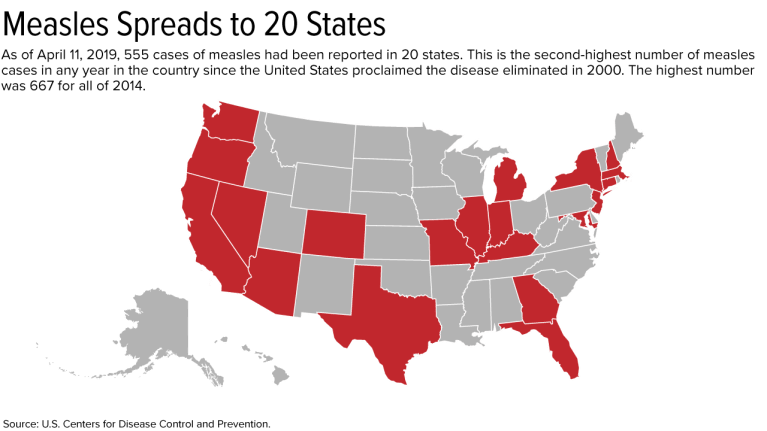Can Employers Require Measles Vaccines?
Can employers require that their employees get the measles vaccine? The recent measles outbreak is raising the question of whether employers can require that their workers get the vaccine. Read this blog post from SHRM to learn more.
The recent measles outbreak, resulting in mandatory vaccinations in parts of New York City, raises the question of whether employers can require that workers get the vaccine to protect against measles, mumps and rubella (MMR) or prove immunity from the illness.
The answer generally is no, but there are exceptions.
Offices and manufacturers probably can't require vaccination or proof of immunity because the Americans with Disabilities Act (ADA) generally prohibits medical examinations—unless the employer is in a location like Williamsburg, the neighborhood in Brooklyn where vaccinations are now mandatory. Health care providers, schools and nursing homes, however, probably can require them because their employees work with patients, children and people with weak immune systems who risk health complications from measles.
But even these employers must try to find accommodations for workers who object to vaccines for a religious reason or because of a disability that puts them at risk if they're vaccinated, such as having a weak immune system.
Proof of Immunity
Proof of immunity includes one of the following:
- Written documentation of adequate vaccination.
- Laboratory evidence of immunity.
- Laboratory confirmation of measles.
- Birth before 1957. The measles vaccine first became available in 1963, so those who were children before the late 1950s are presumed to have been exposed to measles and be immune.
Measles, which is contagious, typically causes a high fever, cough and watery eyes, and then spreads as a rash. Measles can lead to serious health complications, especially among children younger than age 5. One or two out of 1,000 people who contract measles die, according to the U.S. Centers for Disease Control and Prevention.
Outbreak Has Spread to 20 States
As of April 11, 555 cases have been reported in the United States this year. This is the second-greatest number in any year since the United States proclaimed measles eliminated in 2000; 667 cases were reported in all of 2014.
On April 9, New York City Mayor Bill de Blasio declared a public health emergency in Williamsburg, requiring the MMR vaccine in that neighborhood. Those who have not received the MMR vaccine or do not have evidence of immunity may be fined $1,000.
Since the outbreak started, 285 cases have been confirmed in Williamsburg, including 21 hospitalizations and five admissions to intensive care units.
If a city requires vaccinations, an employer's case for requiring them is much stronger, said Robin Shea, an attorney with Constangy, Brooks, Smith & Prophete in Winston-Salem, N.C. But employers usually should not involve themselves in employees' health care unless they are making an inquiry related to a voluntary wellness program, or the health issue is job-related, she cautioned.
The measles outbreak has spread this year to 20 states—outbreaks linked to travelers who brought measles to the U.S. from other countries, such as Israel, Ukraine and the Philippines, where there have been large outbreaks.
Strike the Right Balance
Health care employers typically require vaccinations or proof of immunity as a condition of employment, said Howard Mavity, an attorney with Fisher Phillips in Atlanta. He noted that most schoolchildren must be immunized, so many employees can show proof of immunity years later.
If an employee provides current vaccination records when an employer asks, the ADA requires that those records be kept in separate, confidential medical files, noted Meredith Shoop, an attorney with Littler in Cleveland.
All employers must balance their health and safety concerns with the right of employees with disabilities to reasonable accommodations under the ADA and the duty to accommodate religious workers under Title VII of the Civil Rights Act of 1964.
Under the ADA, a reasonable accommodation is required unless it would result in an undue hardship or direct threat to the safety of the employee or the public. The direct-threat analysis will be different for a registered nurse than for someone in a health care provider's billing department, for example, who might not work around patients.
Even if the ADA permitted mandatory vaccines in a manufacturing setting in limited circumstances, such as in Williamsburg now, any vaccination orders may need to be the subject of collective bargaining if the factory is unionized. Shoop has seen manufacturers shut down because employees were reluctant to come to work when their co-workers were sick on the job.
An employer does not have to accommodate someone who objects to a vaccine merely because he or she thinks it might do more harm than good but doesn't have an ADA disability or religious objection, said Kara Shea, an attorney with Butler Snow in Nashville, Tenn.
If someone claims to have a health condition that makes getting vaccinated a health risk, the employer does not have to take the person's word for it. The employer instead should ask the person to sign a consent form allowing the employer to learn about the condition and get documentation from the employee's doctor, she said. Before accommodating someone without an obvious impairment, the ADA allows employers to require medical documentation of the disability.
Courts don't closely scrutinize religious objections to immunizations, Mavity remarked.
"Some people have extremely strong beliefs that they don't want a vaccine in their body," said Kathy Dudley Helms, an attorney with Ogletree Deakins in Columbia, S.C. If the employer works with vulnerable people but can't find an accommodation for a worker who refuses vaccination, the employee may have to work elsewhere, she said.
SOURCE: SHRM (17 April 2019) "Can Employers Require Measles Vaccines?" (Web Blog Post). Retrieved from https://www.shrm.org/resourcesandtools/legal-and-compliance/employment-law/pages/measles-outbreak-2019-vaccinations.aspx
Working interviews: How hiring trend can cause compliance issues
The federal government prefers that companies do not bring in applicants for a working interview and without paying them. Continue reading this blog post to learn how this hiring trend can cause compliance issues for companies.
News flash: The feds don’t like it when you bring in “applicants” for a “working interview” – and then refuse to pay them for the work they perform.
The lesson is going to cost a Nashville dental practice $50,000 after a settlement in federal district court.
The practice will pay $50k in back wages and liquidated damages to 10 employees for FLSA minimum wage, overtime and recordkeeping violations.
According to the DOL’s Wage and Hour Division, Smiley Tooth Spa:
- violated the federal minimum wage requirements by requiring candidates for hire to perform a “working interview” to conclude their application, but failed to pay the individuals for those hours worked
- failed to pay registered dental assistants and hygienists time-and-a-half for hours worked over 40 in a workweek
- authorized their accountant to falsify and alter time and payroll records to make it appear that the employer was paying proper overtime for all hours worked, and
- periodically required employees to attend training during their scheduled lunch breaks without paying them for that time.
THE CARDINAL RULE
Although it’s hard to believe that any employer could think such an approach could fly in this day and age, this case is a good reminder that people who perform duties for the benefit of any organization are, almost universally, entitled to be paid.
Even if they aren’t yet considered an “official” employee, they’re performing the work of one, and must be paid for it.
Some good news: With working interviews, employers don’t necessarily have to pay the position’s advertised salary. The law only says workers must receive at least minimum wage for their work, so companies do have some flexibility.
SOURCE: Cavanaugh, L. (1 March 2019) "Working interviews: How hiring trend can cause compliance issues" (Web Blog Post). Retrieved from https://www.hrmorning.com/working-interviews-how-hiring-trend-can-cause-compliance-issues/
DOL Focuses on ‘Joint Employer’ Definition
On April 1, the U.S. Department of Labor (DOL) announced a proposed rule that narrows the definition of "joint employer" under the Fair Labor Standards Act (FLSA). Read this blog post from SHRM to learn more about this proposed rule.
The U.S. Department of Labor (DOL) announced on April 1 a proposed rule that would narrow the definition of "joint employer" under the Fair Labor Standards Act (FLSA).
The proposed rule would align the FLSA's definition of joint-employer status to be consistent with the National Labor Relations Board's proposed rule and update the DOL's definition, which was adopted more than 60 years ago.
Four-Factor Test
The proposal addresses the circumstances under which businesses can be held jointly responsible for certain wage violations by contractors or franchisees—such as failing to pay minimum wage or overtime. A four-factor test would be used to analyze whether a potential joint employer exercises the power to:
- Hire or fire an employee.
- Supervise and control an employee's work schedules or employment conditions.
- Determine an employee's rate and method of pay.
- Maintain a worker's employment records.
The department's proposal offers guidance on how to apply the test and what additional factors should and shouldn't be considered to determine joint-employer status.
"This proposal would ensure employers and joint employers clearly understand their responsibilities to pay at least the federal minimum wage for all hours worked and overtime for all hours worked over 40 in a workweek," according to the DOL.
In 2017, the department withdrew an interpretation that had been issued by former President Barack Obama's administration that broadly defined "joint employer."
The Obama-era interpretation was expansive and could be taken to apply to many companies based on the nature of their business and relationships with other companies—even when those relationships are not generally understood to create a joint-employment relationship, said Mark Kisicki, an attorney with Ogletree Deakins in Phoenix.
The proposed test aligns with a more modern view of the workplace, said Marty Heller, an attorney with Fisher Phillips in Atlanta. The test is a modified version of the standard that some federal courts already apply, he noted.
Additional Clarity
Significantly, the proposed rule would remove the threat of businesses being deemed joint employers based on the mere possibility that they could exercise control over a worker's employment conditions, Heller said. A business may have the contractual right under a staffing-agency or franchise agreement to exercise control over employment conditions, but that's not the same as doing so.
The proposal focuses on the actual exercise of control, rather than potential (or reserved) but unexercised control, Kisicki explained.
The rule would also clarify that the following factors don't influence the joint-employer analysis:
- Having a franchisor business model.
- Providing a sample employee handbook to a franchisee.
- Allowing an employer to operate a facility on the company's grounds.
- Jointly participating with an employer in an apprenticeship program.
- Offering an association health or retirement plan to an employer or participating in a plan with the employer.
- Requiring a business partner to establish minimum wages and workplace-safety, sexual-harassment-prevention and other policies.
"The proposed changes are designed to reduce uncertainty over joint employer status and clarify for workers who is responsible for their employment protections, promote greater uniformity among court decisions, reduce litigation and encourage innovation in the economy," according to the DOL.
The proposal provides a lot of examples that are important in the #MeToo era, said Tammy McCutchen, an attorney with Littler in Washington, D.C., and the former head of the DOL's Wage and Hour Division under President George W. Bush.
Importantly, companies would not be deemed joint employers simply because they ask or require their business partners to maintain anti-harassment policies, provide safety training or otherwise ensure that their business partners are good corporate citizens, she said.
Review Policies and Practices
Employers and other interested parties will have 60 days to comment on the proposed rule once it is published in the Federal Register. The DOL will review the comments before drafting a final rule—which will be sent to the Office of Management and Budget for review before it is published.
"Now is the time to review the proposal and decide if you want to submit a comment," Heller said. Employers that wish to comment on the proposal may do so by visiting www.regulations.gov.
"Take a look at what's been proposed, look at the examples in the fact sheet and the FAQs," McCutchen said. Employers may want to comment on any aspects of the examples that are confusing or don't address a company's particular circumstances. "Start thinking about your current business relationships and any adjustments that ought to be made," she said, noting that the DOL might make some changes to the rule before it is finalized.
"The proposed rule will not be adopted in the immediate future and will be challenged at various steps by worker-advocacy groups, so it will be quite some time before there is a tested, final rule that employers can safely rely upon," Kisicki said.
SOURCE: Nagele-Piazza, L. (1 April 2019) "DOL Focuses on ‘Joint Employer’ Definition" (Web Blog Post). Retrieved from https://www.shrm.org/resourcesandtools/legal-and-compliance/employment-law/pages/labor-department-seeks-to-revise-joint-employer-rule.aspx
DOL proposes $35K overtime threshold
Recently, the Department of Labor proposed an increase in the salary threshold for overtime eligibility. The current overtime threshold is set at $23, 660. Continue reading this blog post to learn more about this proposed change.
The Labor Department proposed to increase the salary threshold for overtime eligibility to $35,308 a year, the agency announced late Thursday.
If finalized, the rule’s threshold — up from the current $23,660 — would expand overtime eligibility to more than a million additional U.S. workers, far fewer than an Obama administration rule that was struck down by a federal judge in 2017.
Unless exempt, employees covered by the Fair Labor Standards Act must receive at least time and one-half their regular pay rate for all hours worked over 40 in a workweek.
The proposal doesn’t establish automatic, periodic increases of the salary threshold as the Obama proposal had. Instead, the department is asking the public to weigh in on whether and how the Labor Department might update overtime requirements every four years.
The department’s long-awaited proposal comes after months of speculation from employers and will likely be a target of legal challenges from business groups concerned about rising administrative challenges of the rule. The majority of business groups were critical of Obama’s overtime rule, citing the burdens it placed particularly on small businesses that would be forced to roll out new systems for tracking hours, recordkeeping and reporting.
Labor Secretary Alexander Acosta said in a statement that the new proposal would “bring common sense, consistency, and higher wages to working Americans.”
Under the Obama administration, the Labor Department in 2016 doubled the salary threshold to roughly $47,000, extending mandatory overtime pay to nearly 4 million U.S. employees. But the following year, a federal judge in Texas ruled that the ceiling was set so high that it could sweep in some management workers who are supposed to be exempt from overtime pay protections. Business groups and 21 Republican-led states then sued, challenging the rule.
The Department said it is asking for public comment for periodic review to update the salary threshold.
SOURCE: Mayer, K. (7 March 2019) "DOL proposes $35K overtime threshold" (Web Blog Post). Retrieved from https://www.employeebenefitadviser.com/news/dol-proposes-35k-overtime-threshold?brief=00000152-1443-d1cc-a5fa-7cfba3c60000
Everything employers need to know about employee job classifications
FLSA job classifications can confuse even the most experienced HR managers. Continue reading this blog post for everything employers should know about employee job classifications.
Chief among the issues that keep employers up at night is staying compliant with federal and state employment laws.
Arguably, wage and hour rules are the most complex and cause the most issues for companies. Job classifications under the FLSA can confuse even the most experienced HR managers.
In fact, some of the costliest wage and hour lawsuits and penalties on record could have been avoided if only the employer properly classified an employee as either exempt or nonexempt. It’s critically important to understand the law — and the devil is in the details.
Exempt or nonexempt?
Most employers understand that an exempt employee is not entitled to receive overtime pay for hours worked in excess of forty hours per week, according to the provisions of the FLSA. Conversely, nonexempt employees are required to receive overtime pay and should be classified as nonexempt from these same overtime provisions.
While it may sound straightforward, figuring out an employee’s exempt status is not that simple. Different types of exemptions exist and each has its own unique set of requirements that are outlined in the FLSA. Most of these exemptions are specific to certain jobs or industries, for example, some exemptions only apply to specific types of agricultural workers, or to truck drivers who transport goods in interstate commerce. But for most businesses, exempt employees will usually fall into one of the following three exemption categories: executive, administrative and professional. Collectively, these are referred to as the white collar exemptions.
A common error that employers make is to classify all their salaried employees, or all employees with the word manager in their title, as exempt. Neither of these factors alone is enough to make the exempt designation. Each of the white-collar exemptions has two components: a salary requirement and a duties requirement. The salary requirement is the same for each of the three exemptions, but the duties requirements are different.
The salary basis test
For any employee to be considered exempt under any of the white-collar exemptions, they must be paid on a salary basis. This means that any employee who is paid by the hour, per day, or is commission-only, regardless of their title or position, will not meet the criteria for any of the white-collar exemptions. How the salary is paid as well as the amount are also subject to certain restrictions. The salary basis test determines the minimum amount, which is subject to change from time to time. The minimum salary is currently $455.00 per week (or $23,660 per year). This test also provides restrictions on when and how an employer can make deductions from an exempt employee’s salary.
An increase to the minimum salary per week from $455 to $913 (or $47,476 per year) was originally scheduled to go into effect back in December 2016, but industry groups against the measure successfully lobbied to block it. The U.S. Department of Labor is exploring alternatives that could appease these industry groups while keeping the regulations in line with the times. The DOL is scheduled to re-start the rulemaking process in March 2019, and prior statements of the current DOL Secretary, Alexander Acosta, suggest that the new rule may propose a more modest salary increase to around $634 per week (or around $33,000 per year).
Job duties
In addition to the salary, each white-collar exemption has its own unique set of duties requirements. Employers must look at the actual duties that each employee performs to determine whether they meet the criteria and their title or position does little to influence the outcome. So, simply naming an employee a manager does not automatically qualify the worker as an exempt employee. To be considered exempt under the executive exemption, which is the most common exemption for managers, this employee would need to supervise two or more full-time employees (or the equivalent) and have the authority to hire and fire employees. Otherwise, they would need to meet the requirements for one of the other exemptions to be paid in this manner.
Knowing that these regulations exist and being well-informed of the framework is the first step in understanding overtime obligations – and reducing wage and hour worries. Employers should seek a qualified employment law attorney for additional guidance on the specifics of each requirement to ensure compliance with applicable overtime laws.
SOURCE: Starkman, J.; Nadal, A. (15 February 2019) "Everything employers need to know about employee job classifications" (Web Blog Post). Retrieved from https://www.benefitnews.com/opinion/what-employers-need-to-know-about-job-classifications?brief=00000152-14a5-d1cc-a5fa-7cff48fe0001
Employee wellness programs and compliance: What to know right now
How do you decipher any given wellness program's compliance under the law? Under the Health Insurance Portability & Accountability Act (HIPAA) current guidance, employers need to assess whether the plan is “purely participatory” or “health-contingent.” Read this blog post to learn more about wellness program regulations.
Defining “wellness” for any one person is no simple task, and neither is deciphering a given wellness program’s compliance under the law.
In 2016, when the Equal Employment Opportunity Commission (EEOC) released its final regulations defining a “voluntary” program under the Americans with Disabilities Act (ADA), the entire landscape — at least what can be seen on a hazy day — appeared defined. But thanks to AARP’s successful challenge to these regulations and the EEOC’s recent acknowledgment of the demise of its incentive limitations, employers find themselves back in the “Wild West” of sorts for wellness compliance.
That being said, the uncertainty is not new for employers with wellness programs, and there is now more guidance than before, so let’s take a moment to take in the current view.
The current guidance under the Health Insurance Portability & Accountability Act (HIPAA) remains unchanged, so any wellness program integrated with a health plan or otherwise constituting a health plan itself, employers need to assess whether the plan is “purely participatory” or “health-contingent.” The health-contingent plans (which condition the award of incentives on accomplishing a health goal) will require additional compliance considerations, including—but not limited to—incentive limitations, reasonable alternative standards (RAS), and notice requirements.
The RAS should be of particular importance because they can be missed most out of the compliance parameters. Often there is an “accidental” program such as a tobacco surcharge, and the employer does not even realize the wellness rules are implicated, or the employer’s RAS is another health-contingent parameter that actually necessitates another RAS.
The Department of Labor is actively enforcing compliance in this area, so employers will want to take care.
Additionally, the EEOC’s ADA (and Genetic Information Nondiscrimination Act) regulations are still largely in force. This seems to be a common misconception—ranging from a celebration of no rules to a lament for the end of incentivized wellness programs that include disability-related questionnaires (like an average health risk assessment) or medical examinations (including biometric screenings).
The truth is somewhere in the middle.
The ADA’s own RAS and notice concepts still apply, along with confidentiality requirements. All that has changed is that the EEOC has declined (again) to tell us at what point an incentive turns a program compulsory. So employers sponsoring wellness programs subject to the ADA have three choices, based on risk tolerance (In truth, there are four options, but charging above the ADA’s previous incentive limitations would be excessively risky):
- Run incentives for ADA plans up to the 30 percent cap that existed before. This is the riskiest approach. To take this route, an employer must rely upon HIPAA’s similar (though not exactly the same) incentive limitations as indicative of non-compulsory levels. The fact that Judge Bates did not accept this argument in the AARP case advises against this approach, but this case does not have global application. If this path is chosen, it will be imperative to document analysis as to why this incentive preserves voluntariness for your participants.
- Keep the incentives below the previous 30 percent cap but incentivize the program. This approach does have risk because no one knows at what point an incentive takes choice away from participants. However, the incentive is a useful tool to motivate and reward health-conscientious behavior. The wellness incentive limitations stood at 20 percent under the HIPAA regulations for quite some time without much concern, so this could be a relatively safe target. But the most important thing is to carefully assess the overall structure of the program(s) offered, consider the culture and demographics of the employees who may participate, and balance the desire to motivate against the particular tensions of the program to decide on a reasonable incentive. Make sure to document this analysis and reconsider it every time a program changes.
- Not incentivize the program at all. This is the most conservative approach from a compliance perspective but ultimately not required. Before the EEOC’s 2016 regulations, employers were incentivizing programs subject to the ADA, and nothing about the AARP case or the EEOC’s response to it prohibits incentives.
There’s no doubt the wellness compliance landscape has changed a little over this last year, but this is also just the tip of the iceberg. With enforcement heating up, it is imperative for employers to carefully consider compliance, document the reasonableness of incentive choices and lean on trusted counsel when necessary to avoid potentially costly and time-consuming issues.
SOURCE: Davenport, B. (13 February 2019) "Employee wellness programs and compliance: What to know right now" (Web Blog Post). Retrieved from https://www.benefitspro.com/2019/02/13/employee-wellness-programs-and-compliance-what-to-know-right-now/
Don’t Forget to Post OSHA Injury and Illness Data at Your Worksite
Employers who are covered by the Occupational Safety and Health Administration's (OSHA's) record-keeping rule must post a summary of 2018 work-related injury and illnesses in a noticeable place from Feb. 1 to April 30. Read this blog post from SHRM to learn more.
Employers that are covered by the Occupational Safety and Health Administration's (OSHA's) record-keeping rule must post a summary of 2018 work-related injury and illnesses in a noticeable place from Feb. 1 to April 30. Here are some compliance tips for employers to review.
Required Posting
Many employers with more than 10 employees—except for those in certain low-risk industries—must keep a record of serious work-related injuries and illnesses. But minor injuries that are treated only by first aid do not need to be recorded.
Employers must complete an incident report (Form 301) for each injury or illness and log work-related incidents on OSHA Form 300. Form 300A is a summary of the information in the log that must be posted in the worksite from Feb. 1 to April 30 each year.
"This information helps employers, workers and OSHA evaluate the safety of a workplace, understand industry hazards, and implement worker protections to reduce and eliminate hazards," according to OSHA's website.
Employers should note that they are required to keep a separate 300 log for each "establishment," which is defined as "a single physical location where business is conducted or where services or industrial operations are performed."
If employees don't work at a single physical location, then the establishment is the location from which the employees are supervised or that serves as their base.
Employers frequently ask if they need to complete and post Form 300A if there were no injuries at the relevant establishment. "The short answer is yes, " said Tressi Cordaro, an attorney with Jackson Lewis in Washington, D.C. "If an employer recorded no injuries or illnesses in 2018 for that establishment, then the employer must enter 'zero' on the total line."
Correct Signature
Before the OSHA Form 300A is posted in the worksite, a company executive must review it and certify that "he or she has examined the OSHA 300 Log and that he or she reasonably believes, based on his or her knowledge of the process by which the information was recorded, that the annual summary is correct and complete," according to OSHA.
A common mistake seen on 300A forms is that companies forget to have them signed, noted John Martin, an attorney with Ogletree Deakins in Washington, D.C.
There are only four company representatives who may certify the summary:
- An owner of the company.
- An officer of the corporation.
- The highest-ranking company official working at the site.
- The immediate supervisor of the highest-ranking company official working at the site.
Businesses commonly make the mistake of having an HR or safety supervisor sign the form, said Edwin Foulke Jr., an attorney with Fisher Phillips in Atlanta and Washington, D.C., and the former head of OSHA under President George W. Bush.
They need to get at least the plant manager to sign it, he said, noting that the representative who signs Form 300A must know how numbers in the summary were obtained.
Once the 300A form is completed, it should be posted in a conspicuous place where other employment notices are usually posted.
Electronic Filing
The Improve Tracking of Workplace Injuries and Illnesses rule requires covered establishments with at least 20 employees to also electronically submit Form 300A to OSHA.
Large establishments with 250 or more employees were also supposed to begin electronically submitting data from the 300 and 301 forms in 2018, but the federal government recently eliminated that requirement. However, those establishments still must electronically submit their 300A summaries.
The deadline to electronically submit 2018 information is March 2.
SOURCE: Nagele-Piazza, L. (1 February 2019) "Don’t Forget to Post OSHA Injury and Illness Data at Your Worksite" (Web Blog Post). Retrieved from https://www.shrm.org/resourcesandtools/legal-and-compliance/employment-law/pages/don%E2%80%99t-forget-to-post-osha-injury-and-illness-data-at-your-worksite.aspx/
U.S. Department of Labor's New Compliance Assistance Tool
On February 6, 2019, the U.S. Department of Labor announced the launch of the electronic version of their Compliance Assistance Tool (Handy Reference Guide to the Fair Labor Standards Act (FLSA)). This new version will assist employers by providing them with basic Wage and Hour Division (WHD) information, as well as links to other resources.
This electronic resource was created as a part of the WHD's efforts to modernize compliance assistance tools, as well as provide easy-to-use, accessible compliance information. In coexistence with worker.gov, employer.gov, and other online tools, this tool will help improve employer understanding of federal labor laws and regulations.
View the digital Compliance Assistance Tool here.
Read the DOL's full press release here.
SOURCE: U.S. Department of Labor (6 February 2019) "U.S. Department of Labor Announces New Compliance Assistance Tool" (Web Press Release). Retrieved from https://www.dol.gov/newsroom/releases/whd/whd20190206-0
Developing guidance could free employers from ACA mandate
A future path for employers to avoid ACA employer mandate penalties was outlined in a recent IRS notice. Read this blog post from Employee Benefits News to learn more.
A recent IRS notice provides a future path for employers to avoid ACA employer mandate penalties by reimbursing employees for a portion of the cost of individual insurance coverage through an employer-sponsored health reimbursement arrangement.
While the notice is not binding and at this stage is essentially a discussion of relevant issues, it does represent a significant departure from the IRS’s current position that an employer can only avoid ACA employer mandate penalties by offering a major medical plan.
Here is everything employers need to know.
Background: As described in more detail in a previous update, the ACA currently prohibits (except in limited circumstances) an employer from maintaining an HRA that reimburses the cost of premiums for individual health insurance policies purchased by employees in the individual market.
Proposed regulations issued by the IRS and other governmental agencies would eliminate this prohibition, allowing an HRA to reimburse the cost of premiums for individual health insurance policies (individual coverage HRA) provided that the employer satisfies certain conditions.
The preamble of the proposed regulations noted that the IRS would issue future guidance describing special rules that would permit employers who sponsor individual coverage HRAs to be in full compliance with the ACA’s employer mandate. As follow up, the IRS recently issued Notice 2018-88, which is intended to begin the process of developing guidance on this issue.
On a high level, the ACA’s employer mandate imposes two requirements in order to avoid potential tax penalties: offer health coverage to at least 95% of full-time employees (and dependents); and offer “affordable” health coverage that provides “minimum value” to each full-time employee (the terms are defined by the ACA and are discussed further in these previous updates).
Offering health coverage to at least 95% of full-time employees: Both the proposed regulations and notice provide that an individual coverage HRA plan constitutes an employer-sponsored health plan for employer mandate purposes. As a result, the proposed regulations and notice provide that an employer can satisfy the 95% offer-of-coverage test by making its full-time employees (and dependents) eligible for the individual coverage HRA plan.
Affordability: The notice indicates that an employer can satisfy the affordability requirement if the employer contributes a sufficient amount of funds into each full-time employee’s individual coverage HRA account. Generally, the employer would have to contribute an amount into each individual coverage HRA account such that any remaining premium costs (for self-only coverage) that would have to be paid by the employee (after exhausting HRA funds) would not exceed 9.86% (for 2019, as adjusted) of the employee’s household income.
Because employers are not likely to know the household income of their employees, the notice describes that employers would be able to apply the already-available affordability safe harbors to determine affordability as it relates to individual coverage HRAs. The notice also describes new safe harbors for employers that are specific to individual coverage HRAs, intending to further reduce administrative burdens.
Minimum value requirement: The notice explains that an individual coverage HRA that is affordable will be treated as providing minimum value for employer mandate purposes.
Next steps: Nothing is finalized yet. Employers are not permitted to rely on the proposed regulations or the notice at this time. The proposed regulations are aimed to take effect on Jan. 1, 2020, if finalized in a timely matter. The final regulations will likely incorporate the special rules contemplated by the notice (perhaps with even more detail). Stay tuned.
This article originally appeared on the Foley & Lardner website. The information in this legal alert is for educational purposes only and should not be taken as specific legal advice.
SOURCE: Simons, J.; Welle, N. (17 January 2019) "Developing guidance could free employers from ACA mandate" (Web Blog Post). Retrieved from https://www.benefitnews.com/opinion/developing-guidance-could-free-employers-from-aca-mandate?brief=00000152-14a5-d1cc-a5fa-7cff48fe0001
Compliance: Yearly Deadlines for Health Plans
Do you offer group health plans coverage to your employees? Employers that provide coverage are subject to multiple compliance requirements throughout the year. Certain requirements have been around for many years, while others have been recently added by the Affordable Care Act (ACA).
Continue reading for a summary of the many compliance requirements and their associated deadlines that health plan providers should be aware of throughout the year. Certain deadlines for non-calendar year plans may vary from what is outlined in this summary. This summary only covers recurring calendar year compliance deadlines. Other requirements that are not based on the calendar year are not included below.
January
| Deadline | Requirement | Description |
|
January 31 |
Form W-2 | Deadline for providing Forms W-2 to employees. The ACA requires employers to report the aggregate cost of employer-sponsored group health plan coverage on their employees’ Forms W-2. The purpose is to provide employees with information on how much their health coverage costs. Certain types of coverage are not required to be reported on Form W-2.
This Form W-2 reporting requirement is currently optional for small employers (those who file fewer than 250 Forms W-2). Employers that file 250 or more Forms W-2 are required to comply with the ACA’s reporting requirement. |
| January 31 | Form 1095-C or Form 1095-B—Annual Statement to Individuals | Applicable large employers (ALEs) subject to the ACA’s employer shared responsibility rules must furnish Form 1095-C (Section 6056 statements) annually to their full-time employees. Employers with self-insured health plans that are not ALEs must furnish Form 1095-B (Section 6055 statements) annually to covered employees.
The Forms 1095-B and 1095-C are due on or before Jan. 31 of the year immediately following the calendar year to which the statements relate. Extensions may be available in certain limited circumstances. However, an alternate deadline generally is not available for ALEs that sponsor non-calendar year plans.
Update: The IRS extended the deadline for furnishing the 2018 employee statements, from Jan. 31, 2019, to March 4, 2019. |
February
| Deadline | Requirement | Description |
|
February 28 (March 31, if filing electronically) |
Section 6055 and 6056 Reporting | Under Section 6056, ALEs subject to the ACA’s employer shared responsibility rules are required to report information to the IRS about the health coverage they offer (or do not offer) to their full-time employees. ALEs must file Form 1094-C and Form 1095-C with the IRS annually.
Under Section 6055, self-insured plan sponsors are required to report information about the health coverage they provided during the year. Self-insured plan sponsors must generally file Form 1094-B and Form 1095-B with the IRS annually. ALEs that sponsor self-insured plans are required to report information to the IRS under Section 6055 about health coverage provided, as well as information under Section 6056 about offers of health coverage. ALEs that sponsor self-insured plans will generally use a combined reporting method on Form 1094-C and Form 1095-C to report information under both Sections 6055 and 6056. All forms must be filed with the IRS annually, no later than Feb. 28 (March 31, if filed electronically) of the year following the calendar year to which the return relates. Reporting entities that are filing 250 or more returns must file electronically. There is no alternate filing date for employers with non-calendar year plans. |
March
| Deadline | Requirement | Description |
|
March 1 (calendar year plans) |
Medicare Part D Disclosure to CMS | Group health plan sponsors that provide prescription drug coverage to Medicare Part D eligible individuals must disclose to the Centers for Medicare & Medicaid Services (CMS) whether prescription drug coverage is creditable or not. In general, a plan’s prescription drug coverage is considered creditable if its actuarial value equals or exceeds the actuarial value of the Medicare Part D prescription drug coverage. Disclosure is due:
Plan sponsors must use the online disclosure form on the CMS Creditable Coverage webpage. |
July
| Deadline | Requirement | Description |
|
July 31 |
PCORI Fee | Deadline for filing IRS Form 720 and paying Patient-Centered Outcomes Research Institute (PCORI) fees for the previous year. For insured health plans, the issuer of the health insurance policy is responsible for the PCORI fee payment. For self-insured plans, the PCORI fee is paid by the plan sponsor.
The PCORI fees are temporary—the fees do not apply to plan years ending on or after Oct. 1, 2019. This means that, for calendar year plans, the PCORI fees do not apply for the 2019 plan year. |
|
July 31 |
Form 5500 | Plan administrators of ERISA employee benefit plans must file Form 5500 by the last day of the seventh month following the end of the plan year, unless an extension has been granted. Form 5500 reports information on a plan’s financial condition, investments and operations. Form 5558 is used to apply for an extension of two and one-half months to file Form 5500.
Small health plans (fewer than 100 participants) that are fully insured, unfunded or a combination of insured/unfunded, are generally exempt from the Form 5500 filing requirement. The Department of Labor’s (DOL) website and the latest Form 5500 instructions provide information on who is required to file and detailed information on filing. |
September
| Deadline | Requirement | Description |
|
September 30 |
Medical Loss Ratio (MLR) Rebates | The deadline for issuers to pay medical loss ratio (MLR) rebates for the 2014 reporting year and beyond is Sept. 30. The ACA requires health insurance issuers to spend at least 80 to 85 percent of their premiums on health care claims and health care quality improvement activities. Issuers that do not meet the applicable MLR percentage must pay rebates to consumers.
Also, if the rebate is a “plan asset” under ERISA, the rebate should, as a general rule, be used within three months of when it is received by the plan sponsor. Thus, employers who decide to distribute the rebate to participants should make the distributions within this three-month time limit. |
|
September 30 |
Summary Annual Report | Plan administrators must automatically provide participants with the summary annual report (SAR) within nine months after the end of the plan year, or two months after the due date for filing Form 5500 (with approved extension).
Plans that are exempt from the annual 5500 filing requirement are not required to provide an SAR. Large, completely unfunded health plans are also generally exempt from the SAR requirement. |
October
| Deadline | Requirement | Description |
|
October 15 |
Medicare Part D – Creditable Coverage Notices | Group health plan sponsors that provide prescription drug coverage to Medicare Part D eligible individuals must disclose whether the prescription drug coverage is creditable or not. Medicare Part D creditable coverage disclosure notices must be provided to participants before the start of the annual coordinated election period, which runs from Oct. 15-Dec. 7 of each year. Coverage is creditable if the actuarial value of the coverage equals or exceeds the actuarial value of coverage under Medicare Part D. This disclosure notice helps participants make informed and timely enrollment decisions.
Disclosure notices must be provided to all Part D eligible individuals who are covered under, or apply for, the plan’s prescription drug coverage, regardless of whether the prescription drug coverage is primary or secondary to Medicare Part D. Model disclosure notices are available on CMS’ website. |
Annual Notices
| Type of Notice | Description |
| WHCRA Notice | The Women’s Health and Cancer Rights Act (WHCRA) requires group health plans that provide medical and surgical benefits for mastectomies to also provide benefits for reconstructive surgery. Group health plans must provide a notice about the WHCRA’s coverage requirements at the time of enrollment and on an annual basis after enrollment. The initial enrollment notice requirement can be satisfied by including the information on WHCRA’s coverage requirements in the plan’s summary plan description (SPD). The annual WHCRA notice can be provided at any time during the year. Employers with open enrollment periods often include the annual notice with their open enrollment materials. Employers that redistribute their SPDs each year can satisfy the annual notice requirement by including the WHCRA notice in their SPDs.
Model language is available in the DOL’s compliance assistance guide. |
| CHIP Notice | If an employer’s group health plan covers residents in a state that provides a premium subsidy under a Medicaid plan or CHIP, the employer must send an annual notice about the available assistance to all employees residing in that state. the annual CHIP notice can be provided at any time during the year. Employers with annual enrollment periods often provide CHIP notice with their open enrollment materials.
The DOL has a model notice that employers may use. |
| Group health plans and health insurance issuers are required to provide an SBC to applicants and enrollees each year at open enrollment or renewal time. The purpose of the SBC is to allow individuals to easily compare their options when they are shopping for or enrolling in health plan coverage. Federal agencies have provided a template for the SBC, which health plans and issuers are required to use.
The issuer for fully insured plans usually prepares the SBC. If the issuer prepares the SBC, an employer is not also required to prepare an SBC for the health plan, although the employer may need to distribute the SBC prepared by the issuer. The SBC must be included in open enrollment materials. If renewal is automatic, the SBC must be provided no later than 30 days prior to the first day of the new plan year. However, for insured plans, if the new policy has not yet been issued 30 days prior to the beginning of the plan year, the SBC must be provided as soon as practicable, but no later than seven business days after the issuance of the policy. |
|
| Grandfathered Plan Notice | To maintain a plan’s grandfathered status, the plan sponsor or must include a statement of the plan’s grandfathered status in plan materials provided to participants describing the plan’s benefits (such as the summary plan description, insurance certificate and open enrollment materials). The DOL has provided a model notice for grandfathered plans. This notice only applies to plans that have grandfathered status under the ACA. |
| Notice of Patient Protections | If a non-grandfathered plan requires participants to designate a participating primary care provider, the plan or issuer must provide a notice of patient protections whenever the SPD or similar description of benefits is provided to a participant. This notice is often included in the SPD or insurance certificate provided by the issuer (or otherwise provided with enrollment materials).
The DOL provided a model notice of patient protections for plans and issuers to use. |
| HIPAA Privacy Notice | The HIPAA Privacy Rule requires self-insured health plans to maintain and provide their own privacy notices. Special rules, however, apply for fully insured plans. Under these rules, the health insurance issuer, and not the health plan itself, is primarily responsible for the privacy notice.
Self-insured health plans are required to send the privacy notice at certain times, including to new enrollees at the time of enrollment. Thus, the privacy notice should be provided with the plan’s open enrollment materials. Also, at least once every three years, health plans must either redistribute the privacy notice or notify participants that the privacy notice is available and explain how to obtain a copy. The Department of Health and Human Services (HHS) has model Privacy Notices for health plans to choose from. |
| HIPAA Special Enrollment Notice | At or prior to the time of enrollment, a group health plan must provide each eligible employee with a notice of his or her special enrollment rights under HIPAA. This notice should be included with the plan’s enrollment materials. It is often included in the health plan’s SPD or insurance booklet. Model language is available in the DOL’s compliance assistance guide. |
| Wellness Notice HIPAA | Employers with health-contingent wellness programs must provide a notice that informs employees that there is an alternative way to qualify for the program’s reward. This notice must be included in all plan materials that describe the terms of the wellness program. If wellness program materials are being distributed at open enrollment (or renewal time), this notice should be included with those materials. Sample language is available in the DOL’s compliance assistance guide. |
| Wellness Notice ADA | To comply with the Americans with Disabilities Act (ADA), wellness plans that collect health information or involve medical exams must provide a notice to employees that explains how the information will be used, collected and kept confidential. Employees must receive this notice before providing any health information and with enough time to decide whether to participate in the program. Employers that are implementing a wellness program for the upcoming plan year should include this notice in their open enrollment materials. The Equal Employment Opportunity Commission has provided a sample notice for employers to use. |
Resources: https://www.ada.gov/; https://www.dol.gov/; https://www.hhs.gov/hipaa/for-professionals/privacy/guidance/model-notices-privacy-practices/index.html; https://www.cms.gov/Medicare/Prescription-Drug-Coverage/CreditableCoverage/Model-Notice-Letters.html; https://www.irs.gov/retirement-plans/retirement-plan-participant-notices-when-the-end-of-the-plan-year-has-passed; https://www.cms.gov/cciio/programs-and-initiatives/health-insurance-market-reforms/medical-loss-ratio.html; https://www.dol.gov/sites/default/files/ebsa/about-ebsa/our-activities/resource-center/publications/compliance-assistance-guide.pdf; https://www.dol.gov/agencies/ebsa/laws-and-regulations/laws/affordable-care-act/for-employers-and-advisers/preexisting-condition-exclusions; https://www.dol.gov/agencies/ebsa/laws-and-regulations/laws/affordable-care-act/for-employers-and-advisers/summary-of-benefits; https://www.dol.gov/agencies/ebsa/laws-and-regulations/laws/chipra/working-group; https://www.dol.gov/agencies/ebsa/laws-and-regulations/laws/whcra; https://www.dol.gov/agencies/ebsa/employers-and-advisers/plan-administration-and-compliance/reporting-and-filing/forms; https://www.irs.gov/newsroom/patient-centered-outcomes-research-institute-fee; https://www.irs.gov/affordable-care-act/individuals-and-families/form-1095-b-what-you-need-to-do-with-this-form; https://www.irs.gov/affordable-care-act/individuals-and-families/form-1095-c-what-you-need-to-do-with-this-form; https://www.cms.gov/Medicare/Prescription-Drug-Coverage/CreditableCoverage/index.html?redirect=/CreditableCoverage/; https://www.irs.gov/affordable-care-act/questions-and-answers-on-information-reporting-by-health-coverage-providers-section-6055; https://www.irs.gov/affordable-care-act/employers/questions-and-answers-on-reporting-of-offers-of-health-insurance-coverage-by-employers-section-6056; https://www.irs.gov/forms-pubs/about-form-w-2;











